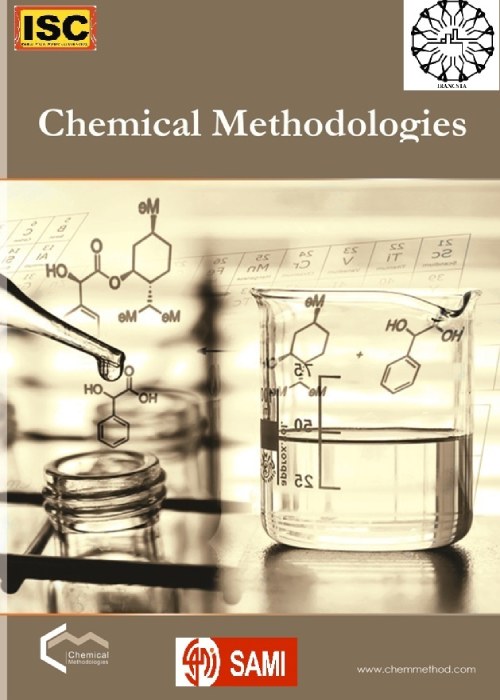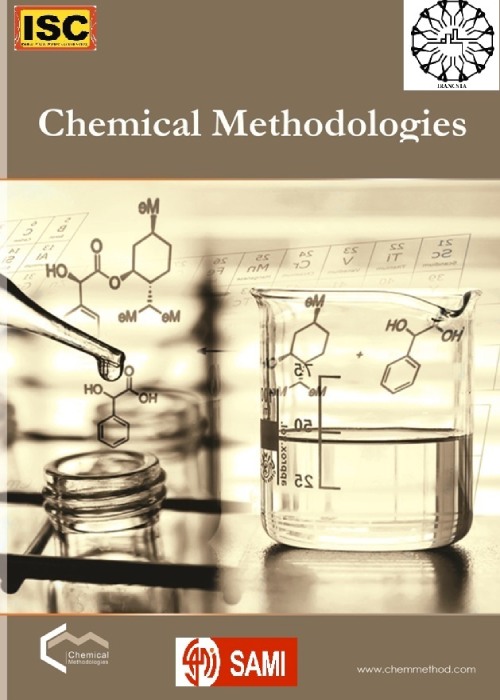فهرست مطالب

Chemical Methodologies
Volume:8 Issue: 2, Feb 2024
- تاریخ انتشار: 1402/11/12
- تعداد عناوین: 5
-
-
Pages 72-84
This study investigated the potential of pristine and Al-doped BN nanoclusters (B12N12, AlB11N12) as adsorbents and sensing materials for the removal and detection of Chloral hydrate (CH) using density functional theory computations. The calculated values of adsorption energies, ΔGad, ΔHad, and Kth revealed that CH interaction with B12N12 is experimentally impossible, endothermic, and non-spontaneous. However, the CH adsorption on the AlB11N12 is exothermic, spontaneous, and experimentally feasible. The influence of solvent was also considered, and the results indicated that the presence of water does not significantly affect the interactions. Furthermore, the Natural Bond Orbital (NBO) computations showed that no chemical bond has formed between the adsorbate and adsorbent, indicating that the interactions between CH and both nanoclusters are due to physisorption. Moreover, frontier molecular orbital calculations indicated that while the bandgap of B12N12 remains largely unchanged during the CH adsorption process, the bandgap of AlB11N12 increases by 132.693% from 4.270 eV to 9.936 eV. In conclusion, the theoretical findings suggest that the Al-doped nanocluster, AlB11N12, has the potential to be an excellent adsorbent and sensor for the removal and detection of Chloral hydrate. This study provides valuable insights into the use of nanoclusters in environmental and analytical applications, highlighting the potential for developing efficient materials for CH removal and detection. Further experimental validation of these theoretical findings could pave the way for the practical application of Al-doped boron nitride nanoclusters in addressing environmental and analytical challenges associated with Chloral hydrate.
Keywords: Chloral hydrate, Adsorption, Boron nitride nanocage, Density functional theory, B3LYP, 6-31G (d) -
Pages 85-95Small molecules from natural origin, particularly compounds extracted from honeybee pollen, possess good biological potential. Bear this in mind; this study utilized a molecular docking protocol to explore the antiviral potential of 100 natural compounds extracted from honeybee pollen, from various botanical origins from throughout the world, targeting the SARS-CoV-2 main protease (Mpro). The docking analysis identified six natural compounds-Luteolin-7-glucuronide, Narigenin, Genistin, Selagin, 1-p-tolyl-anthraquinon, and Resveratrol-with the strongest binding energies to the viral protease. Subsequent investigations delved into the pharmacokinetic characteristics of these compounds. Notably, all six natural compounds were found to bind to the catalytic pocket through hydrogen bonding and hydrophobic interactions with the Cys-His catalytic dyad (Cys145 and His41). These interactions could impede substrate binding in the catalytic pocket, disrupting the catalytic function of the viral receptor by blocking the nucleophilic attack of Cys145 on the substrate. Furthermore, pharmacokinetic assessments indicated that two natural compounds, Narigenin and Selagin, exhibited excellent pharmacological properties, demonstrated low to moderate toxicity, and were capable of crossing the blood-brain barrier- a crucial factor for accessing the viral protease. In light of these findings, it can be inferred that Narigenin and Selagin may possess high potential for inhibiting the enzymatic activities of the SARS-CoV-2 Mpro. Consequently, further studies are warranted to validate their antiviral efficacy.Keywords: COVID-19, Main protease, Molecular docking, natural inhibitors
-
Pages 96-122
The use of polymers modified with folic acid in drug delivery to treat many diseases has long captivated the attention of scientists. Given the distinctive characteristics of folic acid in the realms of food, pharmaceuticals, and chemicals, this review explores the methods employed in bonding folic acid to diverse polymers through the lens of organic synthesis. Furthermore, it examines the behavior of folic acid that has been conjugated to different polymers in drug delivery, along with the interaction between folic acid and folate acceptors. It is important to acknowledge that the articles employed in this review span the years 2002 to 2023.
Keywords: Folic acid, Natural Endocytosis Pathways, Drug Delivery -
Pages 123-132In the present study, a fast, sensitive, and simple electrochemical sensor based on screen-printed graphite electrode (SPGE) modified with Ce-1,3,5-benzenetricarboxylic acid (Ce-BTC) metal-organic framework (MOF) has been prepared for determination of metronidazole (MNZ). The electrochemical studies and measurements were done using cyclic voltammetry (CV), linear sweep voltammetry (LSV), differential pulse voltammetry (DPV), and chronoamperometry techniques. Comparison study of electrochemical performance of unmodified SPGE and Ce-BTC MOF/SPGE toward the reduction of MNZ was evaluated by using CV. The CV studies show that modification of SPGE surface with Ce-BTC MOF enhances the reduction peak current but the peak potential of MNZ has shifted to the lower potential. Using the effects of Ce-BTC MOF, the developed modified SPGE showed good electrochemical sensing performance for detecting MNZ in phosphate buffer solution (PBS) (pH = 7.0) with wide linear range (0.05-400.0 µM), high sensitivity (-0.0304 µA/µM), and low limit of detection (LOD) (0.02 µM). Finally, for the MNZ analysis in real samples, the Ce-BTC MOF/SPGE sensor exhibited good MNZ determination performance with acceptable recoveries of 96.7%-103.6% and low relative standard deviation (RSD) values of 1.8%-3.5%.Keywords: Ce-BTC metal-organic framework, Screen-printed graphite electrode, Electrochemical sensor, Metronidazole
-
Pages 133-153Diesel fuel can be substituted with biodiesel fuel. Burning biodiesel results in less pollution because its source is vegetable or animal fat. Waste cooking oil (WCO) was utilized in this study as a raw source to produce biodiesel. In the WCO under study, the percentage of free fatty acids (FFAs) was 4.09%. The process of turning used cooking oil waste into biodiesel involved two steps. The initial phase was studying the photocatalytic esterification of methanol with FFAs in WCO under visible irradiation using Cr (x%)-TiO2. Triglycerides and methanol were transesterified in the second stage, which was catalyzed by NaOH. When TiO2 was present, efficiency was shown to increase by 10% when compared to the absence of a photocatalyst. Cr-TiO2 photo-esterification reaction has an equivalent order of one. The realisation of the reaction under mild conditions was confirmed by the activation energy of 31.36 kJ/mol needed for the Cr-TiO2 photocatalyst to photo-esterify WCO. Our hypothesis for the esterification process took into account the formation of H+, CH3OO·, and R-COOH on the photocatalyst surface. OH- was thought to be the active species in the transesterification reaction process. The density of the produced biodiesel was 0.89 g.cm-3, per the data that were obtained. For biodiesel, the results yield a falling point of -5 and a cloud point of 0, respectively. The biodiesel made from waste oil had a viscosity of 4.1 mm2.s−1, which was within the standard range. The biodiesel sample made from waste oil has an acid value of 0.38 mg KOHKeywords: Biodiesel, Two dimensional, photocatalyst, Waste oil, Kinetics, Esterification


